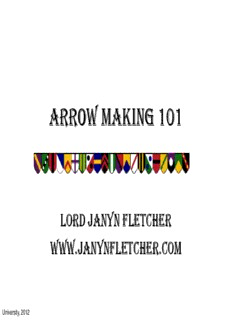
Arrow Making 101 PDF
Preview Arrow Making 101
Arrow Making 101 Lord Janyn Fletcher WWW.Janynfletcher.com University, 2012 CLASS AGENDA • Introduction • Advantages of Arrow Making Customizing your arrows Better control over tuning aspects • Components Review What makes an arrow? Selection of components based on your needs • Spine Explained Static Spine Dynamic Spine • Forward of Center Explained • Arrow Design and Creativity • Safety • Building Arrows ADVANTAGES of MAKING YOUR OWN ARROWS • Increased accuracy • Ability to weight match shafts • Ability to spine match shafts • More attention to your requirements (not mass produced) • Ability to customize your arrows • Able to design whatever you wish for color and design • Able better tune your arrows to your equipment • Better selection of components • Don’t have to take what is available • Can select what you really want to use • You can experiment with new designs • It’s fun and rewarding! THE COMPONENTS Arrow Description About the Arrow: Arrows have four parts; the shaft, fletching, the nock and the point. The Shaft: Arrows are made from wood, aluminum, carbon, fiberglass or a combination of these materials. As suspected, the wood arrows are usually preferred for use with traditional longbows or recurve bow hunters. The tubular aluminum are most popular for Bowhunters because of their light weight and strength. They can accept either plastic vanes or feather fletching. The tubular carbon arrow is also know for its speed, light weight, and accuracy. It is smaller in diameter than other arrow shafts. The Fletching: Serves to guide the arrow on a straight course. The Nock: Placed in the bowstring to allow the arrow to be drawn back as the hunter draws the bow string. The Point: Depending on if you are target practicing or hunting, you will use either a field point or a razor-sharp broad head. Arrow Building Components Wood Arrow Shafts Wood Arrow Shafting: Wood arrows come in many different types of wood, (Port Orford Cedar, Sitka Spruce, Ash, etc…) They also come in various sizes, 5/16, 11/32 and 23/64’s diameter. Hex Arrow Shafting: A new technology using a hybrid construction technique . Typical Arrow Shafting: Typical grain pattern for most wood arrows. Arrow Building Components Fletching Arrow Building Components Points Field Points: Field Points come in various sizes and weights. It is important to pick the correct size and weight for your application. Brass Points: Brass Points come in various sizes and weights. It is important to pick the correct size and weight for your application. Brass points are more expensive to use. Bodkin Points: Bodkin points, although being period are most times not allowed on the ranges because they destroy the targets and backers quickly. Arrow Building Components Nocks Classic Nocks: Classic nocks are good nocks and work quite well. They come in different sizes and colors. Snap Nocks: Snap nocks are also good nocks, but they lack the index tab on them. Also they are designed to “snap” on your string.
Description: